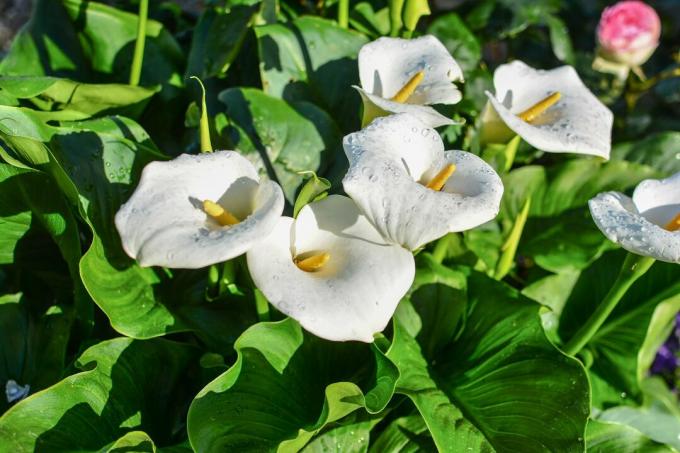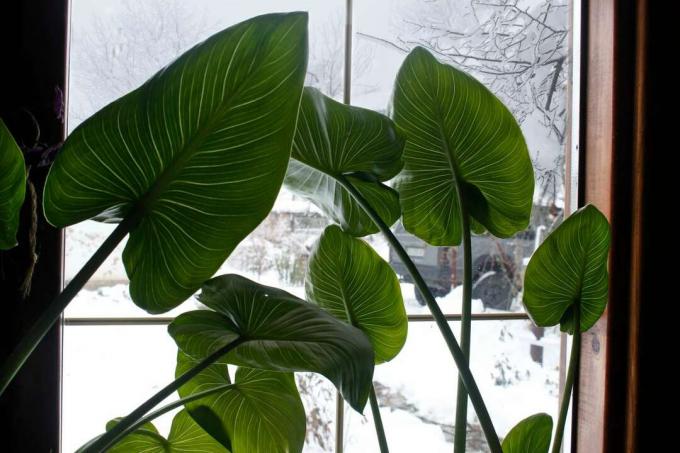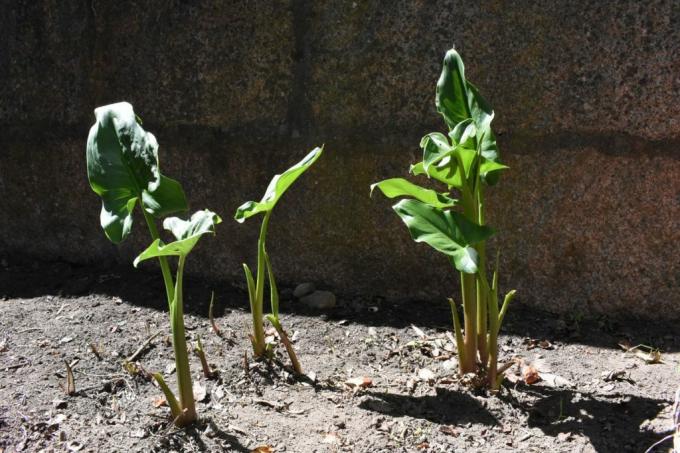Even an exotic plant like the calla can survive our winter unscathed. We show when, where and how to successfully overwinter callas and how to properly care for them in the cold period.

The Calla (Zantedeschia aethiopica) is often also called Zantedeschia. What is meant is an exotic plant that impresses with its large, impressive flowers. It can be used as a houseplant in a pot for a jungle feeling in the home or office, or decorate the garden with its blooms in summer. But with one exception, these plants cannot survive the winter outdoors in our country. In this article, we explain how your Calla can be preserved for many years.
Are callas hardy?
The calla does not come from Ethiopia, as the botanical name suggests Zantedeschia aethiopica would suggest, but from South Africa. There the plant is spoiled with warm temperatures all year round, which actually never fall below 20 °C. Accordingly, callas are not hardy and cannot spend the winter outdoors with us. But as we all know, exceptions confirm the rule. There is actually a Calla variety that was specially bred for frost tolerance. 'Crowsborough' flowers in summer and is said to withstand temperatures down to -20°C. In concrete terms, this means that in winter the above-ground plant parts of this hardy Zantedeschia variety freeze or are cut back by you. The tubers remain in the ground all winter and can sprout again in spring. With callas becoming more and more popular in the garden, it is certainly only a matter of time before new frost-tolerant calla cultivars are bred.
Summary: Are callas hardy?
- Normal Calla varieties are not hardy
- The only exception is the cultivar 'Crowsborough'
- As a tuber, it can survive temperatures as low as -20 °C
Tip: Make sure your calla lily is really Zantedeschia aethiopica acts. There is easy confusion with the swamp calla (Calla palustris), also called Drachenwurz, which, in contrast to Zantedeschia, is native to the northern hemisphere and is very hardy.

Hibernate calla properly: Our care tips
In its native South Africa, the Zantedeschia does not know four, but only two seasons: the dry and the rainy season. Therefore, the Calla also needs strict growth phases for a magnificent growth. This means that during the growing season in summer it needs the highest possible temperatures and enough water, while in winter cool temperatures and drought are needed. In the next sections you will learn how to create the ideal conditions in winter for both indoor calla lilies and calla lilies in the garden.
When does the calla get too cold?
Callas or Zantedeschias are unfortunately frostbite and are quickly damaged if the temperatures are too low. Room callas in pots get too cold at temperatures below 15 °C and they should be brought into a warm room quickly. Zantedeschias, which are planted out in summer or spend them in pots in the garden, need appropriate measures from temperatures below 10 °C in order to survive the winter safely. As already mentioned, the only exception so far is the hardy Calla variety 'Crowsborough', which can withstand temperatures down to -20 °C.
Overview: When does the Zantedeschia get too cold?
- Room calla: From temperatures below 15 °C
- Garden calla: From temperatures below 10 °C
- 'Crowsborough': As a tuber, it withstands frost down to -20 °C
Hibernate calla: how and where?
The hibernation of room callas and garden callas differs significantly. While indoor callas can overwinter as a whole plant, callas are dug up from the garden in the fall and only the bulbs are stored over the winter. First, let's take a look at how best to overwinter your room calla: Even in winter, the Zantedeschia needs a location that is as bright as possible, for example on the windowsill. However, you should definitely avoid direct sunlight. The temperature becomes critical, because it should remain constant throughout the winter and, if possible, not fluctuate. At a constant 10 °C, the calla in the pot survives the winter unscathed.
Summary: Overwintering calla in a pot:
- As bright a location as possible, but no direct sunlight
- Ideal temperature: 10°C
- No temperature fluctuations

With the garden calla, a few more steps are necessary to get the plant through the winter well. Start preparing as early as August by stopping the fertilization completely and gradually reducing the watering. At the beginning of October it is then time to dig up the storage organs of the plant, the tubers. Only they are overwintered. From the excavated callas, cut back all above-ground plant parts to two inches. The soil is also carefully tapped or brushed off the tubers. Now dry the tubers on a grid for two to three days. Then the Zantedeschias are ready to move into their winter quarters. A dark, dry place, such as a basement, is ideal for this. During the winter of the callas, the temperatures should never rise above 15 °C, otherwise the plants will start to sprout. However, the temperatures should not fall below 0 °C, otherwise the tubers will freeze to death. Place the tubers in a box filled with dry sand or straw. This allows the calla tubers to rest over the winter and be planted out again in the spring.
Overwintering Garden Calla: Summary:
- Water less from the end of August, stop fertilizing
- Dig the tubers out of the ground in early October
- Cut back all plant parts above ground to 5 cm
- remove soil
- Leave tubers to dry for 2-3 days
- Overwinter in a box with dry sand or straw
- Store in a frost-free, dark and dry place
- Temperatures should never rise above 15°C

Caring for calla in winter
As already mentioned, winter is the dry season for calla lilies. That is why it is only poured very sparingly. Allow the substrate to dry out almost completely before watering again, in very small amounts. There is no fertilizer at all in winter. Unfortunately, Zantedeschias are often plagued by pests during the cold season. Therefore, check the plant regularly for pest infestation. Typical pests on the room calla are aphids (Sternorrhyncha) and spider mites (Tetranychidae). Withered leaf edges and discolored leaves, on the other hand, are indications root rot down, caused by too frequent watering. If you regularly remove dead plant parts from your houseplant, your calla will not need pruning. In spring you can slowly prepare the calla for the rainy season by first increasing the temperature to 12 to 15 °C. Now the plant is slowly starting to grow again and therefore needs more water again. But don't overdo it too much in the beginning, still water moderately. Garden callas, which are overwintered as tubers, do not require any care over the winter.
Caring for calla in winter – overview:
- Water room callas only very sparingly
- No fertilization
- Check regularly for pest infestation
- Remove dead plant parts regularly
- In spring, slowly increase the temperature to 12 – 15 °C
- Constantly increase the amount of water, adjusted to the growth
- Callas overwintered as tubers do not require care
Tip: Always wear gloves for all care measures, because all parts of the calla plant are poisonous.
If you have let your calla hibernate as a tuber, you have two options for hibernating the plant in spring. Either you plant the tubers in a pot first and let them grow indoors, or you save yourself this step and plant the tubers directly outdoors when no more frost is to be expected. Planting the bulbs in pots first will give the plants an advantage and they will start flowering earlier in the year. To do this, prepare a pot of potting soil that you enrich with a slow-release organic fertilizer. Our is particularly suitable for this Plantura organic flower fertilizer, which provides all the important nutrients for your calla. Now the tuber is placed ten centimeters deep in the pot, covered with substrate and watered. The calla can then grow well in a bright place at room temperature. Water them regularly and increase the amounts of water in proportion to growth. The plant can finally be transplanted outdoors in mid-May.
Alternatively, you can also plant the overwintered tubers directly outdoors at the end of May - whether in the garden bed or in the pot is up to you.

How should you winter out garden calla?
- Take tubers out of winter quarters at the beginning of March
- Fill the pot with substrate and a long-acting organic fertilizer
- Plant the tuber 10 cm deep
- Water well
- Place in a bright place at room temperature
- Constantly increase the watering quantity in proportion to growth
- Plant out in mid-May
- Alternatively, no preparation in spring, but tubers in mid/end of May directly in the garden bed or in the garden. plant the pot outdoors
Not all plants need to be overwintered with as much effort as the calla. Many perennials, for example, are hardy and can easily survive the cold season in the garden. Here you will find an overview of our 10 Most Popular Hardy Perennials.



